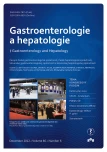Clostridium difficile – a rising threat?
Authors:
M. Bátovský
Authors‘ workplace:
Gastroenterologická klinika SZU a UNB, UN sv. Cyrila a Metoda, Bratislava
Published in:
Gastroent Hepatol 2012; 66(6): 438-443
Category:
Clinical and Experimental Gastroenterology: Review Article
Overview
Clostridium difficile infection (CDI) represents a serious problem in healthcare that continues to evolve, evidenced by increased incidence and greater morbidity and mortality. A symptomatic patient can present with a broad spectrum of disease severity, ranging from mild, watery, self-limiting diarrhoea to life threatening fulminant pseudomembranous colitis, toxic megacolon, bowel perforation, septic shock, and death. Toxin testing is most important clinically, but is hampered by its lack of sensitivity. One potential strategy to overcome this problem is a two-step method that uses enzyme immunoassay detection of glutamate dehydrogenase as an initial screening and then uses a cell cytotoxicity assay or toxigenic culture as the confirmatory test. It is important to stratify the severity of CDI by means of laboratory parameters that may indicate an increased risk of severe outcomes associated with CDI. The currently available treatments for CDI are insufficient to impede the increased spread and virulence of the infection, avoid recurrence or prevent infection in at-risk populations. Current efforts are focused on preservation of the gut microflora and optimization of the immune response to CDI and toxins. Promising therapies still need time to be adopted in routine management of CDI, due to feasibility, acceptability and economic concerns. Improved monitoring, judicious antibiotic use and universal implementation of prevention schemes are paramount to reducing disease incidence and recurrence.
Key words:
Clostrium difficile – infection – diagnostics techniques and procedures – therapeutics
The authors declare they have no potential conflicts of interest concerning drugs, products, or services used in the study.
The Editorial Board declares that the manuscript met the ICMJE „uniform requirements“ for biomedical papers.
Submitted:
3. 7. 2012
Accepted:
1. 9. 2012
Sources
1. Hu MY, Katchar K, Kyne L et al. Prospective derivation and validation of a clinical prediction rule for recurrent Clostridium difficile infection. Gastroenteroogy 2009; 136(4): 1206–1214.
2. Stokowski LA, McDonald LC. Refining our approach to Clostridium difficile prevention. http://www.medscape.com.
3. Khanna S, Pardi D, Aronson SI et al. The epidemiology of community-acquired Clostridium difficile infection: a population-based study. Am J Gastroenterol 2012; 107(1): 89–95.
4. Garcia A. A perspective on community-acquired C. difficile infection. http://www.medscape.com.
5. Loo VG, Poirier L, Miller MA. A predominantly clonal multi-institutional outbreak of Clostridium difficile-associated diarrhea with high morbidity and mortality. N J Engl Med 2005, 353(23): 2433–2441.
6. Louie TJ, Miller MA, Mullane KM et al. Fidaxomicin versus vancomycin for Clostridium difficile infection. N Engl J Med 2011; 364(5): 422–431.
7. Lo Vecchio A, Zacur G. Clostrium difficile infection. An update on epidemiology, risk factors, and therapeutic options. Curr Opin Gastroenterol 2012; 28(1): 1–9.
8. Zuger A. Does recurrent Clostridium difficile infection mean reinfection or relapse? http://www.medscape.com/viewarticle/756741
9. Johnson DA. PPIS and C.difficile: putting the risk in perspective. http://www.medscape.com.
10. Riggs MM, Sethi AK, Zaberski TF. Asymptomatic carriers are a potential source for transmission of epidemic and nonepidemic Clostridium difficile strains among log-term care facility residents. Clin Infect Dis 2007; 45(8): 992–998.
11. Cohen SH, Gerding DN, Johnson S et al. Clinical practice guidelines for Clostridium difficile infection in adults: 2010 update by the Society for healthcare epidemiology of America (SHEA) and the Infectious diseases society of America (IDSA). Infect Control Hosp Epidemiol 2010; 31(5): 5–29.
12. Crobach MJT, Dekkers OM, Wilcox MH et al. European society of clinical microbiology and infectious diseases: Data review and recommendations for diagnosing Clostridium difficile-infection (CDI). Clin Microbiol Infect 2009; 15(12): 1053–1066.
13. Bauer MP, Kuijper EJ, van Dissel JT. ESCMID: Treatment guidance document for Clostrium difficile infection. Clin Microbiol Infect 2009; 15(12): 1067–1079.
14. Ananthakrishnan AN, Guzman-Perez R, Gainer V et al. Predictors of severe outcomes associated with Clostridium difficile infection in patients with inflammatory bowel disease. Aliment Pharmacol Ther 2012; 35(7): 789–795.
15. Neal MD, Alverdy JC, Hall DE et al. Diverting loop ileostomy and colonic lavage: an alternative to totalabdominal colectomy for the treatment of severe, complicated Clostridium difficile associated disease. Ann Surg 2011; 254(3): 423–429.
16. Cornely OA, Crook DW, Esposito R et al. Fidaxomicin versus vancomycin for infection with Clostridium difficile in Europe, Canada, and the USA: a double-blind, non-inferiority, randomized controlled trial. www.thelancet.com/infection. DOI:10.1016/S1473-3099 /11/70374-7.
17. Johnson DA. C.difficile:new therapy for a dangerous disease? http://www.medscape.com/.
18. Auwaerter PG. Fidaxomicin: new drug for Clostridium difficile – where will it fit? http://www.medscape.com.
19. Grens K. Fecal transplant by enema works for Stubborn C. difficile. Ann Intern Med; http://bit.ly/xtXkDN.
20. Harding A. Turmeric enema may equal vancomycin for C. difficile colitis. http://www.medscape.com.
Labels
Paediatric gastroenterology Gastroenterology and hepatology SurgeryArticle was published in
Gastroenterology and Hepatology

2012 Issue 6
Most read in this issue
- Somatostatin and its use
- Omeprazole
- Clostridium difficile – a rising threat?
- Selected gastrointestinal diseases and nutritional disorders associated with osteoporosis
